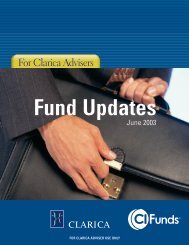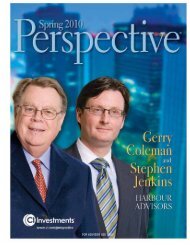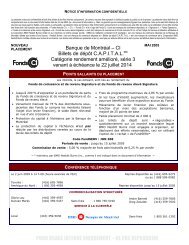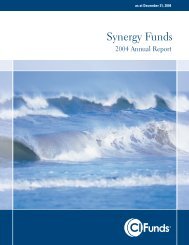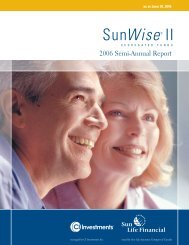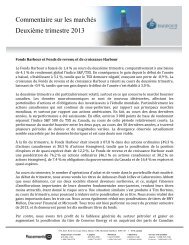July - Summer Edition - CI Investments
July - Summer Edition - CI Investments
July - Summer Edition - CI Investments
You also want an ePaper? Increase the reach of your titles
YUMPU automatically turns print PDFs into web optimized ePapers that Google loves.
Introducing Black Creek<br />
That gives us a sense of how a company is positioned. To us,<br />
it means that they’re leading in market share and growing<br />
market share faster than the competition. In our judgment,<br />
it’s essentially a company that’s going to outpace its industry.<br />
In general, those companies typically have significantly<br />
higher long-term profits and sustainable positions. Our view<br />
may not be the common view, but over time, we feel that<br />
they’re going to do much better than other companies.<br />
A good example is Adidas. We invested in it over a decade ago<br />
when it was viewed as not being as strong as Nike. At the time,<br />
Adidas was a well-known brand that had suffered for lack of<br />
investment. However, it had new management with a lot of<br />
brand experience and there were tailwinds for the industry,<br />
such as demographics. Over the years, they have done a<br />
really great job of rebuilding the brand, taking market share<br />
and building it up in different parts of the world. It’s now to<br />
the point where they’re growing just as fast as Nike. It’s a good<br />
example of identifying a leading company before everyone else<br />
figured that out. Hence, the idea was unique and proprietary.<br />
KANKO: The flip side is also true. If it’s a widely held view<br />
that a company is a leading in its field and the prospects look<br />
great, and we don’t have any view that’s different than the<br />
market view, then we might choose not to own it. A portfolio<br />
is not just what you own – it’s also what you don’t.<br />
[Q] Are there any themes that run through your portfolios?<br />
KANKO: We are not “thematic” investors, but we are<br />
certainly aware of the big picture and the trends and issues<br />
that might impact our investments. For example, we stay on<br />
top of technology and how it could affect various companies<br />
– either positively or negatively. As investors, we are very<br />
conscious of the threat to manufacturers from low-priced<br />
Chinese and Korean suppliers. Another area we follow are<br />
companies that are dependent on government financing or<br />
subsidies because these might have more difficulty in the<br />
future because of the fiscal position of governments. There<br />
are a host of other factors that we consider which could<br />
present investment opportunities or risks.<br />
[Q] The Black Creek portfolios are concentrated –<br />
generally only 20–25 companies. How do you achieve<br />
diversification with such a concentrated portfolio?<br />
JENKINS: From financial theory perspective, 20 to<br />
25 companies is statistically more than enough to achieve<br />
diversification – so long as the businesses are in different<br />
geographies and industries and exposed to different<br />
economic effects. We make sure our portfolio is diversified,<br />
but in the end there has to be someone making decisions<br />
about a portfolio. In order to understand the businesses at<br />
great length, you need to study them, follow them, build<br />
a thesis, and then track them. It’s impossible to do that as a<br />
decision maker if you have100 or 200 companies. No one can<br />
know that many companies in depth. The Black Creek team<br />
is four people. Inside our firm there are about 35 holdings.<br />
Divided by four people, that’s roughly 8 to 9 each. On average,<br />
each person is looking at 10 to 12 companies, and with our<br />
turnover rate of between 20% and 30%, each person is buying<br />
two or three stocks a year. In addition, the discipline of having<br />
20 to 25 companies forces us to make choices between<br />
something that’s good and something that’s even better – which<br />
is hard to do as an investor. It might mean selling something<br />
that’s still undervalued to buy something more undervalued.<br />
In the long run, it ensures that we’re always upgrading the<br />
portfolio. We are always selling our least preferred idea to buy<br />
our most preferred one.<br />
[Q] What are the benefits of a focused portfolio?<br />
KANKO: The biggest benefit of having a focused portfolio is<br />
that it keeps you from getting overly diversified and becoming<br />
like the market. We think that if our investment approach is<br />
correct and we execute properly, we should focus our efforts<br />
on a select group of companies. The shorter list also helps<br />
us stay on top of the companies better and know them a<br />
little better than our competitors. Lastly, it promotes a sell<br />
discipline. If we find a new idea that we like, we have to make<br />
room in the portfolio for it by selling our least favourite idea.<br />
[Q] How do you make that decision to buy or sell one<br />
company instead of another?<br />
KANKO: The selling goes along with the buy process. It’s<br />
having a unique view that is different from everyone else –<br />
and a picture of the company looking out five or 10 years. We<br />
then determine what we think the company is worth based on<br />
that view. If we think it’s worth substantially more than what<br />
the market says, it becomes an idea. That’s how we build the<br />
portfolio. We find 20 or 25 of those ideas, and then the sell<br />
process just follows. If we find something else that we think<br />
is a good idea, we have to make room for it by selling our<br />
least favourite idea. Anything we look at has to compare with<br />
everything we already own. Ideally, we sell to make room for<br />
a new holding, and that maintains the discipline of a focused,<br />
concentrated portfolio. We also sell if there’s a significant<br />
negative change in the business that we think is ongoing, or if<br />
the price gets too high.<br />
SUMMER 2011 PERSPECTIVE AS AT JUNE 30, 2011 3



